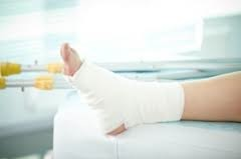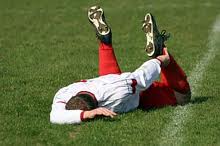Acute Sporting Injuries
It is very important when you sustain an acute soft tissue injury to have it correctly assessed and diagnosed so that your treatment can be specifically tailored to maximise you recovery time.

RICE in the immediate period following an acute soft tissue injury is generally the most appropriate treatment protocol. It it not recommended you use any anti-inflammatory mediation as there is evidence that using them in the early stages of an injury may in fact inhibit/impede tissue recovery. If you require medications for pain relief paracetamol is recommended.
Rest – avoid any movments/activities that aggravate the pain. The tissue needs time to heal and recover. ‘Rest’ for an ankle injury will be quite different to ‘rest’ for a shoulder injury.
Ice – should be applied to the site of injury to reduce the bleeding from the injured tissue. Be careful not to apply the ice directly onto the skin as there is a risk of an ice burn and/or nerve damage. 15 mins ‘on’ every hour is recommended, with reduced frequency over a 48 hour period.
Compression – should be applied around the injury site to assist in reducing the bleeding and swelling. Be careful to apply the bandage/compression firmly around the injury site but ensure it is not too tight as it could restrict circulation to the area.
Elevation – assists in reducing the swelling and pooling of fluid within the injured and surrounding tissue. Upper limbs can be elevated/rested using a sling, but be mindful only to use these for short periods at a time. Lower limb injuries should be elevated so they are higher than the pelvis.
Acute soft tissue injuries vary greatly in recovery times. There are many reason for this including;
- the amount of tissue injured – obviously if a great % of the tissue is injured then recovery time will be longer than an injury where only a small proportion of the tissue was injured
- the type of tissue injured – highly vascular tissue such as muscles tend to have a faster recovery time than tendons who have a smaller vascular supply.
- the health of the injured tissue – it is likely that healthier/fitter tissue will recovery faster than unhealthy/unfit tissue
- the age of the injured tissue – older tissue is likely to have a slower recovery time that younger tissue
- what activity levels you are returning to – the tissue demands of returning to walking 1km is different to the tissue demands of returning to training for a marathon
- history of previous injury to the tissue – if you have had a previous injury to the injured tissue then recovery times may be a little slower than if it was the initial injury to the area

Acute soft tissue injures need to be respected and treated appropriately in order for recovery time to be maximal. At Active Steps Physiotherapy we assess and treat acute sporting injuries, then provide education regarding how best to manage the injury at home in the very early stages. We can also refer you for x-rays/MRI’s if there is a concern about structural damage, or extensive injury. We then guide you through the early stages of rehab with the aim of minimising recovery times, including preventing/minimising loss of muscle strength and flexibility during this recovery phase. Once the injury has reached a certain level of recovery we will guide you through a safe return to sport/training/activity program. Throughout this stage we will educate you on how to minimise the risk of re-injury, and provide advice regarding future injury prevention.

Education and understanding of your musculoskeletal condition is a very important component of injury recovery. Below are links to common musculoskeletal conditions;
